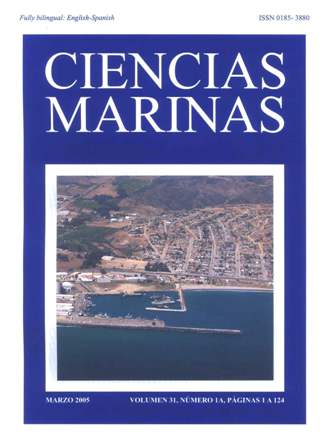Distribution of chlorophyll and primary production by size classes along the Mexican Pacific coast
Main Article Content
Abstract
From 15 January to 4 February, 1999, we carried out an oceanographic cruise along the west coast of Mexico, from the mouth of the Gulf of California to the Gulf of Tehuantepec. For the first time in this region, size-fractionated chlorophyll a and 14C assimilation experiments were carried out at seven stations. Nutrient concentrations (PO4 and SiO2) were also measured. Nutriclines were very shallow and developed within the euphotic zone depth. Sea surface temperature varied from 19.5ºC at the mouth of the Gulf of California to 28.3ºC in the Gulf of Tehuantepec. The integrated euphotic zone chlorophyll a ranged from 16.8 to 95.6 mg m–2 d–1 ( x = 41.4). Daily integrated primary production rates ranged from 0.16 to 1.15 g C m–2 d–1 (x = 0.53). Nanophytoplankton (<20 µm) contributed most to both chlorophyll and primary production (60–100%). Microphytoplankton (>20 µm) was significant only at two southern stations (~30% and 44%). The contribution by the nanophytoplankton size fractions (<20 to >10 µm and <10 to >3 µm) and the picoplancton (<3 to >0.45 µm) was variable. Phytoplankton biomass and primary production rates showed a clear spatial pattern, increasing from north to south.
Downloads
Article Details

This work is licensed under a Creative Commons Attribution 4.0 International License.
This is an open access article distributed under a Creative Commons Attribution 4.0 License, which allows you to share and adapt the work, as long as you give appropriate credit to the original author(s) and the source, provide a link to the Creative Commons license, and indicate if changes were made. Figures, tables and other elements in the article are included in the article’s CC BY 4.0 license, unless otherwise indicated. The journal title is protected by copyrights and not subject to this license. Full license deed can be viewed here.

